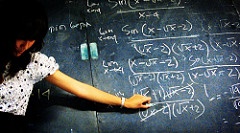“Andrew Hacker, a professor of both mathematics and political science at Queens University has a new book out, The Math Myth: And Other STEM Delusions, which makes the case that the inclusion of algebra and calculus in high school curriculum discourages students from learning mathematics, and displaces much more practical mathematical instruction about statistical and risk literacy, which he calls “Statistics for Citizenship.””
Andrew Hacker has an intriguing idea that the high school math curriculum needs to be radically re-examined. And, no … He’s not talking about Common Core! What if we didn’t teach Algebra II and Calculus in high school and instead taught, “Statistics for Citizenship?” Would there be less math anxiety for students? Would lessening the requirements for some professional training , like EMT training, open professional doors and expand the workforce? Would students be more statistically literate and better citizens? Would we finally be able to answer the age-old, high school question, “When am I going to use calculus in real life?” (And just to be clear … I LOVED math in high school and took every math class that I could!).
Hacker is advocating that teaching statistical literacy explicitly in a classroom devoted to these concepts is better than dedicating part of the day to teaching advanced math. Statistical literacy is one of the main concepts of the grant this year. Overall, I’ve really struggled with looking at how teaching data literacy can be holistically integrated into the curriculum. I want our work to be useful and successful so implementing it is always on my mind
School librarians present an interesting model for holistic integration of any curricular change. While some teachers think that librarians are only working with English or Social Studies teachers, school librarians can work with any teacher — Some work with Health teachers as students create posters representing good health practices. Others work with science fair participants to create solid ideas around the practical application of scientific concepts. The list goes on and on. As one of our Library Development Officers used to say to potential donors, “The Library is for Everybody.” Having a separate statistical literacy class flies in the face of having students see how any information literacy concept is integral to the rest of their work as they encounter the practical application of these ideas throughout their day.
Dedicating part of the day to statistical literacy is intriguing to me. Having a class like this occupy some of the day’s “real estate” would send a signal that statistics for citizenship is important for our children … Yet … I always wonder about the holistic aspect of separating out overriding conceptual ideas into their own place in the curriculum. I struggle with this separation in teaching information literacy too — Why can’t info lit be more grounded into the rest of the curriculum, especially at the college level? I’m not sure that I know the answers to these questions. Maybe we could find a thematic approach — Students could have a separate class AND apply statistical literacy ideas in science, English, government, and other classes. Is that asking too much?
Image: “Calculus” by fitriahandayani on Flickr. CC-BY-2.0. https://flic.kr/p/9yZ1rp
